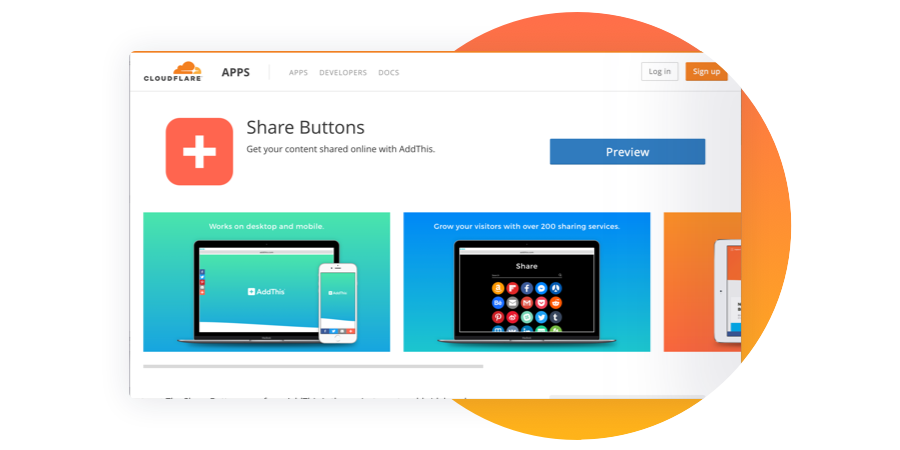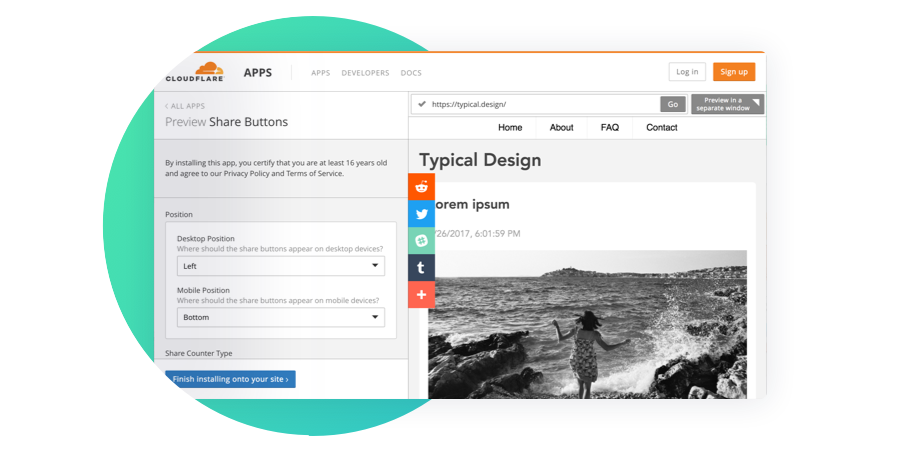This is a guest post by Emily Schwartz, Product Manager for the AddThis team at Oracle. With a background in digital media that has spanned across NPR, WaPo Labs, Trove, and others, Emily cares deeply about helping publishers leverage data and technology for success.
The Process of Paring Down
When our team learned about the opportunity to build an AddThis app on Cloudflare Apps, I was ready to pounce. Building for distribution platforms is a core part of our business and product strategy, and I knew AddThis could bring a lot to the table for Cloudflare users. With a media background in my pocket, I understand the necessity of making content easily and quickly distributable -- and I wanted to get our tools in front of new users so we could learn more about the critical needs of publishers, merchants, and website owners.
The decision to build was the easy part. What to build was the challenging part.
With time and resources tight, I knew building an app that offered our full suite of website tools wouldn’t be immediately feasible—or even make sense. Share buttons, follow buttons, related posts, list building, link promotion, and tip jar are all useful products, but launching with a more narrow tool and feature set meant we could reach the market sooner, learn from user behaviors, and identify needs unique to Cloudflare Apps publishers. I opted to forge ahead with our most popular tool: share buttons.
If you try to configure share buttons from addthis.com, there are a lot of ways to do this: Floating, Inline, Expanded, Image Sharing, Popup, Banner, and Slider. Seven options just for share buttons! My goal with Cloudflare Apps was to launch something simple, useful, and closer to drag-and-drop than code-and-configure. With this in mind, I made a hard decision: pare down our app to the simplest version of our floating sharing sidebar—our most popular share buttons type—and cut many of the advanced configuration options. Instead, I decided to serve auto-personalized buttons and limit settings to cosmetic changes like number of services displayed and bordered styling. Perhaps the biggest change: users don’t even need to register an AddThis account to use our share buttons on Cloudflare Apps or work with any code. We created the simplest version of our share buttons to date.
With the scope trimmed down to “Share Buttons Lite,” we got to work.
The AddThis team is no stranger to building for third-party platforms. Our tools are found on platforms like WordPress, Shopify, Magento, and others. Building for Cloudflare Apps turned out to be more of a dream, better than we could have imagined. There was one wrinkle to figure out: if we weren’t asking users to create or log in to an addthis.com account, how would we save unique configuration settings?
Some background
Every website with AddThis tools has a configuration object where on-page tool settings are stored. This includes configuration data such as layout, color, theme, and social media handles. This data needs to be stored each time tools are updated via the Cloudflare portal and loaded each time a website visitor lands on a page with AddThis tools. Ideally, this information is stored in a database and read each time tools are rendered. While this approach is feasible when users configure tools through the addthis.com dashboard, it’s not an option in Cloudflare Apps.
How to store and render sidebar settings for each user became an anticipated hurdle. Luckily, there was a good solution: save the tool configuration data on a JS global variable using Cloudflare’s suggested INSTALL_SCOPE JS technique and, using the AddThis Smart Layers API, render the tools from this global variable to display in the preview portal. When the user saves their configuration, we call and serve the settings stored on that global variable each time tools need to be rendered.
Anyone can check out this method in action by previewing the AddThis Share Buttons app from Cloudflare Apps and playing around with the tools’ positioning, styling, and other settings.
In the few weeks since our launch, we’ve received a lot of useful feedback—good, bad, and ugly. The Cloudflare Apps developer portal allows developers to view basic metrics and user comments that keep third parties up-to-date about what’s important to websites and publishers. In the future, we’re considering connecting the app to the addthis.com dashboard and including other tool styles or types. We’ve heard a lot about page speed scores and mobile performance being important to users, and I’m pleased to report these are both areas of continued investment for AddThis. Paring down Share Buttons—AddThis’ flagship product—was a risk, and it’s one we’re happy we took.
Check out a live preview of AddThis in Cloudflare Apps »
Want to shape the future of content and sharing? We’re all ears at [email protected] and @addthissupport. Happy sharing.





